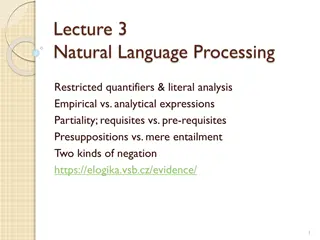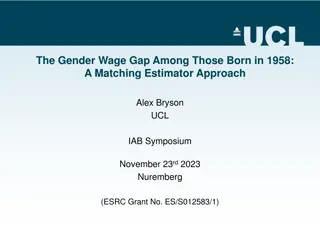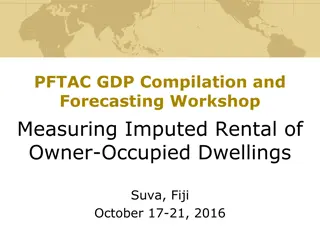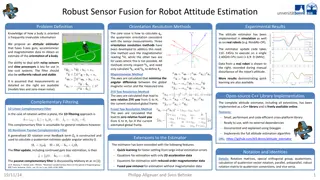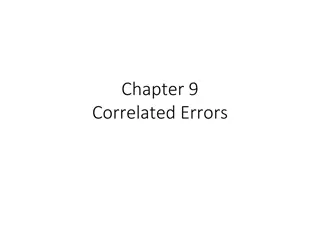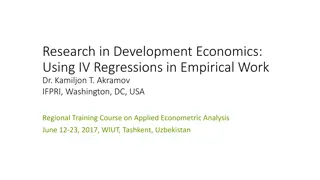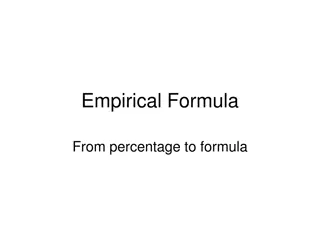Empirical Estimator for GxE Using Imputed Data
Empirical Estimator for GxE using imputed data involves utilizing posterior probabilities to estimate genetic and environmental interactions. The Bayesian approach combines case-only and case-control estimators, adjusting for imputed values to improve accuracy. Challenges such as variance estimation complexity are addressed through integrated modeling strategies.
Download Presentation

Please find below an Image/Link to download the presentation.
The content on the website is provided AS IS for your information and personal use only. It may not be sold, licensed, or shared on other websites without obtaining consent from the author.If you encounter any issues during the download, it is possible that the publisher has removed the file from their server.
You are allowed to download the files provided on this website for personal or commercial use, subject to the condition that they are used lawfully. All files are the property of their respective owners.
The content on the website is provided AS IS for your information and personal use only. It may not be sold, licensed, or shared on other websites without obtaining consent from the author.
E N D
Presentation Transcript
Empirical Estimator for GxE using imputed data Shuo Jiao
Background Empirical Bayes (EB) is a weighted average of case-only and case-control GxE estimator with the greater weight given to the more efficient case-only estimator if the G-E independence is likely to hold, and to the more robust case- control estimator otherwise. The case-control estimator is easy to obtain using standard software The case-only estimator, when g is coded as 0/1, can be obtained from logit(prob(g=1))~e+x
Background When g=0/1/2, in a similar way to Bhattacharjee S et.al. (2010), we can fit a polytomous logistic regression in cases with some constraint The likelihood function is
Background We obtain MLE by solving the score equation (first derivative of the log likelihood function w.r.t the parameters) equal to 0.
Imputed data For imputed data, we only know the posterior probabilities that g=2,1,0; which are denoted by p2, p1 and p0. In the score function, since I(g=2) are I(g=1) are unknown, a na ve approach would be to replace them by the imputation probabilities, however, this will yield biased estimators. Instead, we will replace the indicators by E(I(g=2)|e,x)=prob(g=2|e,x); in cases, e and g are not independent. So prob(g=2|e,x) should be a function of e, x and p2.
Imputed data Suppose the true model is After some derivation, I found out that Note that c1 and c3 are unknown, we proposed to replace c1 and c3 with the corresponding estimate from case control. In this way, we make use of the posterior probabilities from imputation software in an integrated manner. By replace I(g=2) and I(g=1) in the score function with the prob(g=2|e,x) and prob(g=1|e,x), we can get the case only estimators.
Variance of estimators Since in the case-only estimator, we replace c1 and c3 with the corresponding estimators from case control, this introduce more variations and make it complicate to estimate the corresponding variance. Also, this will make the estimate of corresponding variances of the EB estimator much harder. Because EB is a weighted average of case only and case control estimators, to get the variance of EB, we need to compute the covariance of case only and case control estimates. Good thing is the difficulty lies in the math derivation part. Once the algorithm is developed, the speed is not affected much.
EB R Function for Imputed Genotypes EB.function.wt.new(input, model) input=data.frame(d,p1,p2,e,w,x) d: disease status p1 and p2: probabilities of carrying heterozygotic and homozygotic variant genotypes e: environmental variables (categorical, continuous) w: weight for sample x: adjusted covariates (e.g., study, age and sex) model: additive, dominant, recessive Output: a matrix Columns: EST_CO, SE2_CO, EST_CC, SE2_CC, EST_EB, SE2_EB Rows: g*e
Results When SNPs are not imputed, which is equivalent to situations where one of p2 p1 and p0 is 1, our method should give similar results as the regular EB method (in CGEN package). Results are from 5000 replicates. True interaction G and E correlation CGEN_EST CGEN_var Dosage_EST Dosage_var log(1.5) 0 0.409 0.029 0.410 0.029 log(2) 0 0.698 0.029 0.700 0.029 log(1.5) log(1.25) 0.486 0.037 0.487 0.038 log(2) log(1.25) 0.771 0.037 0.772 0.038
Type I error 1000 imputed SNPs, 5% of which are correlated with E, repeat 1000 times, type I error Case-control: 0.048 Case-only: 0.162 EB: 0.039
Estimate When g and e are independent ge.effect r2 bias_EB SE_EB SD_EB bias_CC SE_CC SD_CC 0.182 0.182 0.182 0.182 0.405 0.405 0.405 0.405 0.693 0.693 0.693 0.693 0.25 0.49 0.81 0.98 0.25 0.49 0.81 0.98 0.25 0.49 0.81 0.98 0.003 0.004 0.004 0.002 0.015 0.022 0.001 -0.004 0.05 0.023 0.008 0.006 0.078 0.037 0.021 0.017 0.081 0.036 0.02 0.016 0.083 0.035 0.02 0.017 0.08 0.036 0.021 0.018 0.079 0.035 0.021 0.018 0.08 0.036 0.021 0.018 0.003 0.006 0.006 0.002 0.019 0.027 0.005 -0.004 0.064 0.033 0.014 0.008 0.1 0.101 0.052 0.031 0.026 0.101 0.051 0.031 0.025 0.103 0.052 0.031 0.026 0.052 0.031 0.026 0.104 0.052 0.031 0.025 0.106 0.052 0.03 0.026
Estimate When g and e are correlated (log(1.2)) ge.effect r2 bias_EB SE_EB SD_EB bias_CC SE_CC SD_CC 0.182 0.182 0.182 0.182 0.405 0.405 0.405 0.405 0.693 0.693 0.693 0.693 0.25 0.491 0.81 0.98 0.25 0.491 0.81 0.98 0.25 0.491 0.81 0.98 0.084 0.089 0.076 0.067 0.083 0.09 0.077 0.061 0.124 0.101 0.081 0.064 0.084 0.043 0.027 0.024 0.083 0.043 0.028 0.024 0.088 0.044 0.027 0.023 0.085 0.042 0.028 0.024 0.084 0.042 0.028 0.024 0.085 0.042 0.028 0.025 0.006 0.009 0.006 0.006 0.009 0.011 0.009 -0.001 0.057 0.028 0.012 0.001 0.102 0.053 0.031 0.027 0.101 0.055 0.033 0.027 0.108 0.056 0.031 0.026 0.102 0.052 0.031 0.026 0.102 0.052 0.031 0.026 0.104 0.053 0.032 0.026




